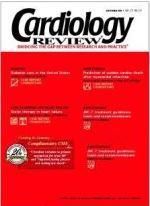Publication
Article
Cardiology Review® Online
Glucose-insulin-potassium: A therapy whose time has come again
The notion that the infusion of glucose, insulin, and potassium (GIK) could reduce infarct size was first proposed by Sodi-Pallares and others in the 1960s.1,2 The proposed (and validated) mechanisms of action of GIK involved shifting myocardial oxidative metabolism from free fatty acids, which are increased in ischemia and toxic to myocardium, to glucose, which is more energy-efficient. Approximately 10% more adenosine triphosphate is synthesized per mole of oxygen when glucose is oxidized as opposed to free fatty acids.3
Despite a number of positive observations in a variety of ischemic circumstances, including several large multicenter trials such as the Diabetes and Insulin Glucose Infusion in Acute Myocardial Infarction (DIGAMI) study,4 which showed a 30% and 25% relative mortality reduction at 1 and 3 years, respectively, and studies by the extracorporeal lung assist (ECLA) group5 and by van der Horst and colleagues,6 which showed that GIK infusion improves survival in the setting of acute myocardial infarction, the strategy has not become “the standard of practice.” The cynical view of this oversight would be that the therapy is not industry-driven; the more benign view would be that alternative reperfusion strategies have a more dramatic impact on survival and preservation of myocardial function.
Nonetheless, GIK refuses to go away, and the article by Lazar and colleagues (page 17) again reminds us of the important role that cardiac metabolism and preferential glucose utilization can play in the preservation of cardiac function, especially in the surgical management of diabetic patients. The authors investigated whether the same strategy of GIK infusion that affected cardiac function in the setting of acute ischemia and infarction might improve postoperative outcomes in diabetic patients undergoing coronary artery bypass graft (CABG) surgery. This is obviously a very important patient group, both because diabetic patients, by definition, have impaired glucose metabolism and are vulnerable to free fatty acid toxicity and because diabetic patients remain a subgroup of patients who appear to benefit from CABG surgery as opposed to percutaneous revascularization.
The authors randomly assigned diabetic patients undergoing CABG surgery to a GIK group (n = 72) or a No-GIK group (n = 69). GIK infusion was initiated before induction of anesthesia and terminated 12 hours after arrival in the intensive care unit. Results of the study showed that GIK patients had significantly better glycemic control not only during the infusion (134.3 ± 3.7 mg/dL in the GIK group versus 266.8 ± 6.3 mg/dL in the No-GIK group; P < .001), but for at least 18 hours afterward (170.6 ± 5.3 mg/dL in the GIK group versus 257.1 ± 6.0 mg/dL in the No-GIK group; P < .001). This resulted in lower serum lactate and free fatty acid levels. In the perioperative period, GIK-treated patients had higher cardiac indices (2.91 ± 0.06 L/min/m2 in the GIK group versus 2.43 ± 0.06 L/min/m2 in the No-GIK group) and required less inotropic support. GIK patients had a lower incidence of atrial fibrillation, need for pacing, ventilatory support, pneumonia, and wound infection. These benefits translated into a shorter postoperative hospital stay (6.5 ± 0.1 days for the GIK group versus 9.2 ± 0.3 days for the No-GIK group; P = .03). Surprisingly, follow-up over a 5-year period showed a significant (P = .04) survival advantage and decreased number of ischemic events in the GIK group (5% for the GIK group versus 19% for the No-GIK group).
This study unequivocally supports the use of GIK infusion in this surgical cohort. The mechanism by which this benefit is achieved is unclear, however, and the broad spectrum of salutary effects suggests that it might encompass more biologic moments than were initially recognized. Certainly, the acute infusion of GIK should shift substrate utilization and could contribute to the hemodynamic effect. Moreover, the reduced utilization of sympathomimetic amines might have an impact on perioperative electrical instability. Whether these outcomes might have been affected solely by tight glycemic control is unclear, as it has been shown that control of glucose levels per se, rather than levels of exogenous insulin, appear to account for the mortality benefit associated with insulin therapy in critically ill patients.7 There is also evidence to suggest that postoperative CABG surgery patients who achieved tight glycemic control by continuous insulin infusion have better outcomes than those with poor control treated with intermittent subcutaneous insulin.8
Beyond this, the authors postulate that additional mechanisms to explain the beneficial effect of GIK might include improved endothelial function, reduced vascular inflammation, and thrombogenicity leading to enhanced graft patency. It is well known that diabetic patients have increased inflammatory biomarkers and that exposure of endothelial cells to proinflammatory cytokines induces procoagulant activity,9 leads to the expression of cell surface adhesion molecules,10 and impairs endothelium-dependent vascular relaxation.11 Unfortunately, no inflammatory biomarkers or measures of endothelial function were obtained, so this potentially important interface cannot be evaluated. Additionally, little information regarding the adequacy of medical treatment prior to and at the time of discharge is provided, nor are there follow-up data on graft patency. These omissions are important, as a growing number of interventions known to decrease cardiovascular risk have been shown to improve endothelial function and reduce inflammatory biomarkers, including HMG-CoA reductase inhibitors (statins)12 and angiotensin-converting enzyme inhibitors.13
These limitations notwithstanding, the study certainly provides a simple and rational adjunctive strategy for surgical management of
diabetic patients. Whether the benefit is broad-based and applies to all patients undergoing CABG surgery or whether it is efficacious only in subgroups of diabetic patients (eg, those with heart failure) remains to be established. In addition, a more nuanced understanding of the mechanisms of benefit will need to emerge from further studies evaluating the relative role of inflammation and metabolic balance. But as it stands, the benefits are already clear. One hopes that the cardiothoracic community will do better than the cardiology community and embrace this simple, inexpensive therapy, which appears to have a very substantial upside and no apparent downside.
